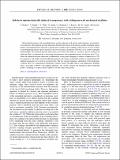Sub-hertz optomechanically induced transparency with a kilogram-scale mechanical oscillator
Author(s)
Bodiya, T; Sudhir, V; Wipf, C; Smith, N; Buikema, A; Kontos, A; Yu, H; Mavalvala, N; ... Show more Show less
DownloadPublished version (923.8Kb)
Publisher Policy
Publisher Policy
Article is made available in accordance with the publisher's policy and may be subject to US copyright law. Please refer to the publisher's site for terms of use.
Terms of use
Metadata
Show full item recordAbstract
© 2019 American Physical Society. Optical interferometers with suspended mirrors are the archetype of all current audio-frequency gravitational-wave detectors. The radiation pressure interaction between the motion of the mirrors and the circulating optical field in such interferometers represents a pristine form of light-matter coupling, largely due to 30 years of effort in developing high-quality optical materials with low mechanical dissipation. However, in all current suspended interferometers, the radiation pressure interaction is too weak to be useful as a resource, and too strong to be neglected. Here, we demonstrate a meter-long interferometer with suspended mirrors, of effective mass 125g, where the radiation pressure interaction is enhanced by strong optical pumping to realize a cooperativity of 50. In conjunction with modest resolved-sideband operation, this regime is efficiently probed via optomechanically induced transparency of a weak on-resonant probe. The low resonant frequency and high-Q of the mechanical oscillator allows us to demonstrate transparency windows barely 100 mHz wide at room temperature. Together with a near-unity (≈99.9%) out-coupling efficiency, our system saturates the theoretical delay-bandwidth product, rendering it an optical buffer capable of seconds-long storage times.
Date issued
2019Department
Lincoln Laboratory; LIGO (Observatory : Massachusetts Institute of Technology)Journal
Physical Review A
Publisher
American Physical Society (APS)